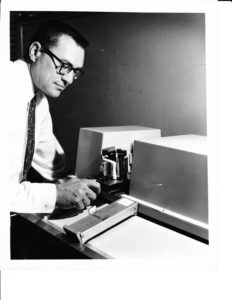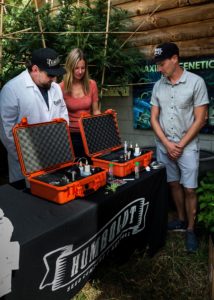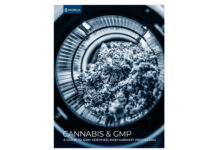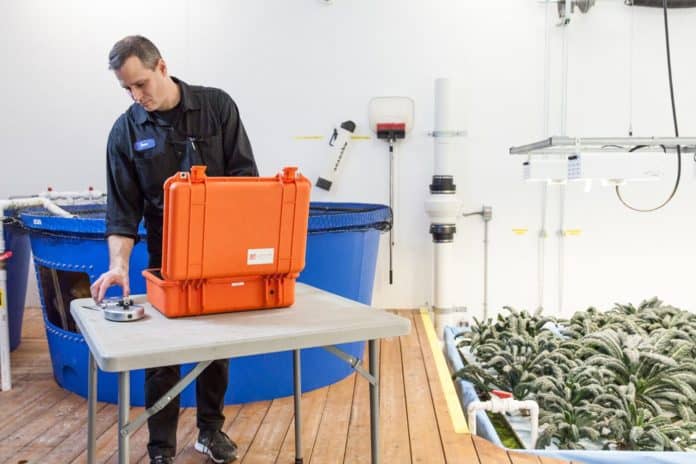In the early days of legal cannabis, some producers were prone to making questionable scientific assertions. Consumers and regulators eventually learned safe recreation and reliable medicine needed more than glib claims about potency and quality. Responsible testing put the pseudoscience behind us and may be one of the biggest contributors to mainstream acceptance of the plant.
Lab-testing cannabis flower and products is not simply encouraged. In most places, it’s the law. Orange Photonics is doing its part to help make the process more convenient for growers and dispensary operators. Formed in 2015 and built on a foundation of hard science, the company has become a recognizable presence. Co-founder Dylan Wilks is a third-generation spectroscopist and the grandson of Paul Wilks, who has been called the “father of mid-infrared technology.”

“Paul was one of the founding members of Pittcon, the world’s leading annual conference and expo for laboratory science,” Orange Photonics co-founder and President Stephanie McArdle said.
Wilks believes science should be precise, fun, and accessible. “Dylan enjoys running experiments and writing about them for our newsletter and blog,” McArdle said. “One of our favorite experiments blasted cannabis with a NASA-grade solar simulator for part three of our ‘Testing for Trust’ series. We wanted to see if and how sunlight impacted cannabinoid content.” Another experiment involved analysis of ten-year-old plants. The blog also features entertaining entries such as “What Does Mars Have to Do with Marijuana?”
Most dispensary operators and cannabis producers have multiple options when it comes to testing, but Orange Photonics’ LightLab is unique: It was designed for farmers to use in the field, literally. The orange box may look like it houses a standard cordless drill or fishing tackle, but that would be a mistaken assumption. “LightLab is a one-pound, portable, easy-to-use cannabis analyzer, which means cannabis operations can bring testing in-house for the first time or offload some of the testing work from their high-end equipment,” McArdle said.

The device measures eight cannabinoids as well as terpenes. It can test both wet and dry plant material in addition to concentrates and infused products such as edibles. The equipment also returns results quickly, making it a potential solution for on-the-spot testing by law enforcement officers and regulatory authorities. “Testing is essential to delivering unique products and a central component of quality control, process optimization, and product consistency,” McArdle said. “National, state, and local agencies are working very hard to develop a framework that ensures consumer safety through transparency and accountability.”
For consumers, testing products can provide peace of mind and reassurance the products they receive are what they expect. “Testing is vital to building trust,” McArdle said. “Some consumers trust regulation and industry oversite will keep them safe, and others are skeptical.”
“The reality is that if we want cannabis to be treated like a medicine, a food product, or an adult recreational product, we need to make sure what we’re offering is safe.” – Stephanie mcardle, co-founder and president, organge photonics
Orange Photonics recently added a new testing module to its flagship instrument. The Hemp THC Compliance module allows hemp and CBD cultivators to be certain that their products do not exceed federal limits. Anything that helps ensure compliance and safety is a welcomed development for the CBD industry. Although the current darling of cannabinoids has shown great potential to deliver relief from a wide variety of ailments, some producers make highly dubious claims. “There are CBD products for sale that are clearly out of compliance, but that will not be the case for long,” McArdle said. “LightLab with the Hemp Compliance Module is the only portable analyzer that allows farmers, processors, and law enforcement to accurately test hemp for THC content outside of the lab.” Hemp-derived products must contain less than 0.3 percent THC.
In Orange Photonics’ world, science can solve a multitude of problems. Science is empirical, though not entirely invulnerable to politics. “In many regards, cannabis is still a bit of an underdog with a bit of a reputation,” McArdle said. “We need to control our image by applying science and proving ourselves time and time again in order to earn legitimacy and trust.
“All eyes are on the cannabis industry,” she added. “Some political camps are waiting for an opportunity to highlight our failure, slow legalization, and block access. I firmly believe science is building a bridge, because it provides a performance standard.”
Substances LightLab Analyzes
THC-A (tetrahydrocannabinolic acid)
CBD (cannabidiol)
CBD-A (cannabidiolic acid)
CBG-A (cannabigerolic acid)
CBC (cannabichromene)
Δ9THC Delta-9-tetrahydrocannabinol)
CBN (cannabinol)
CBG-A (cannabigerolic acid)
CBC (cannabichromine)
Degraded THC.












